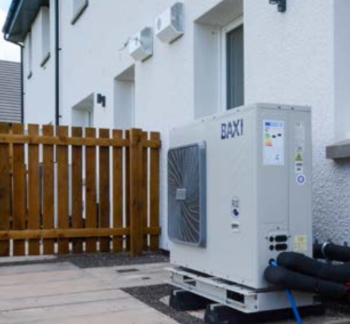Operative temperature
Operative temperature (previously known as resultant temperature or dry resultant temperature, but renamed to align with ASHRAE and ISO standards) is a simplified measure of human thermal comfort derived from air temperature, mean radiant temperature and air speed. It can be useful in assessing the likely thermal comfort of the occupants of a building.
Actual thermal comfort is dependent on environmental factors, such as air temperature, air velocity, relative humidity and the uniformity of conditions, as well as personal factors such as clothing, metabolic heat, acclimatisation, state of health, expectations, and even access to food and drink. However as empirical fits to these variables are very complex (see predicted mean vote), a simpler measure can be more useful in practice.
Operative temperature is defined as:
Operative temperature = (tr + (ta x √10v)) / (1+√10v)
Where
ta = air temperature
v = air speed (m/s)
Or:
Operative temperature = (( hr x tr) + (hc x ta )) / ( hr + hc )
Where
hc = convective heat transfer coefficient
hr = radiative heat transfer coefficient
Where the air speed is less than 0.1m/s, (as is typical in buildings) radiative and convective heat transfers may be similar, and so the equation can be simplified to:
Operative temperature = (ta + tr)/2
In many spaces, with low air velocity and where air temperature and mean radiant temperature may be similar, air temperature alone can be a reasonable indicator of thermal comfort. However, in spaces where surfaces may be heated or cooled, where there is significant thermal mass, or where solar radiation is present, air and radiant temperatures may be very different and so it is necessary to take account of radiant temperatures in assessing thermal comfort...
NB Illustrated Guide to Mechanical Cooling (BG 1/2010), written by Kevin Pennycook and published by BSRIA in 2010, defines resultant temperature as: ‘A temperature often used to specify a design condition for a space, it combines air temperature, surface temperature and air velocity in a single index.’
Thermal Comfort (TG 22/2023) published by BSRIA in 2023 defines operative temperature as: ‘….a measure of thermal comfort which takes into account air temperature, mean radiant temperature and air speed. The term dry resultant temperature was formerly used for this. Operative temperature is a better measure than dry bulb temperature for specifying setpoints within many buildings as it considers the radiative component (from equipment such as chilled ceilings and fabric components such as windows) and air movement in the space.’
[edit] Related articles on Designing Buildings
- BREEAM Thermal comfort.
- Dry-bulb temperature.
- Globe temperature.
- Humidity.
- Maximum and minimum workplace temperatures.
- Mean radiant temperature.
- Predicted mean vote.
- Psychometric chart.
- Running mean temperature.
- Sling psychrometer.
- Thermal comfort.
- Thermal indices.
- Temperature.
- Wet-bulb temperature.
Featured articles and news
Passivhaus social homes benefit from heat pump service
Sixteen new homes designed and built to achieve Passivhaus constructed in Dumfries & Galloway.
CABE Publishes Results of 2025 Building Control Survey
Concern over lack of understanding of how roles have changed since the introduction of the BSA 2022.
British Architectural Sculpture 1851-1951
A rich heritage of decorative and figurative sculpture. Book review.
A programme to tackle the lack of diversity.
Independent Building Control review panel
Five members of the newly established, Grenfell Tower Inquiry recommended, panel appointed.
Welsh Recharging Electrical Skills Charter progresses
ECA progressing on the ‘asks’ of the Recharging Electrical Skills Charter at the Senedd in Wales.
A brief history from 1890s to 2020s.
CIOB and CORBON combine forces
To elevate professional standards in Nigeria’s construction industry.
Amendment to the GB Energy Bill welcomed by ECA
Move prevents nationally-owned energy company from investing in solar panels produced by modern slavery.
Gregor Harvie argues that AI is state-sanctioned theft of IP.
Heat pumps, vehicle chargers and heating appliances must be sold with smart functionality.
Experimental AI housing target help for councils
Experimental AI could help councils meet housing targets by digitising records.
New-style degrees set for reformed ARB accreditation
Following the ARB Tomorrow's Architects competency outcomes for Architects.
BSRIA Occupant Wellbeing survey BOW
Occupant satisfaction and wellbeing tool inc. physical environment, indoor facilities, functionality and accessibility.
Preserving, waterproofing and decorating buildings.





















